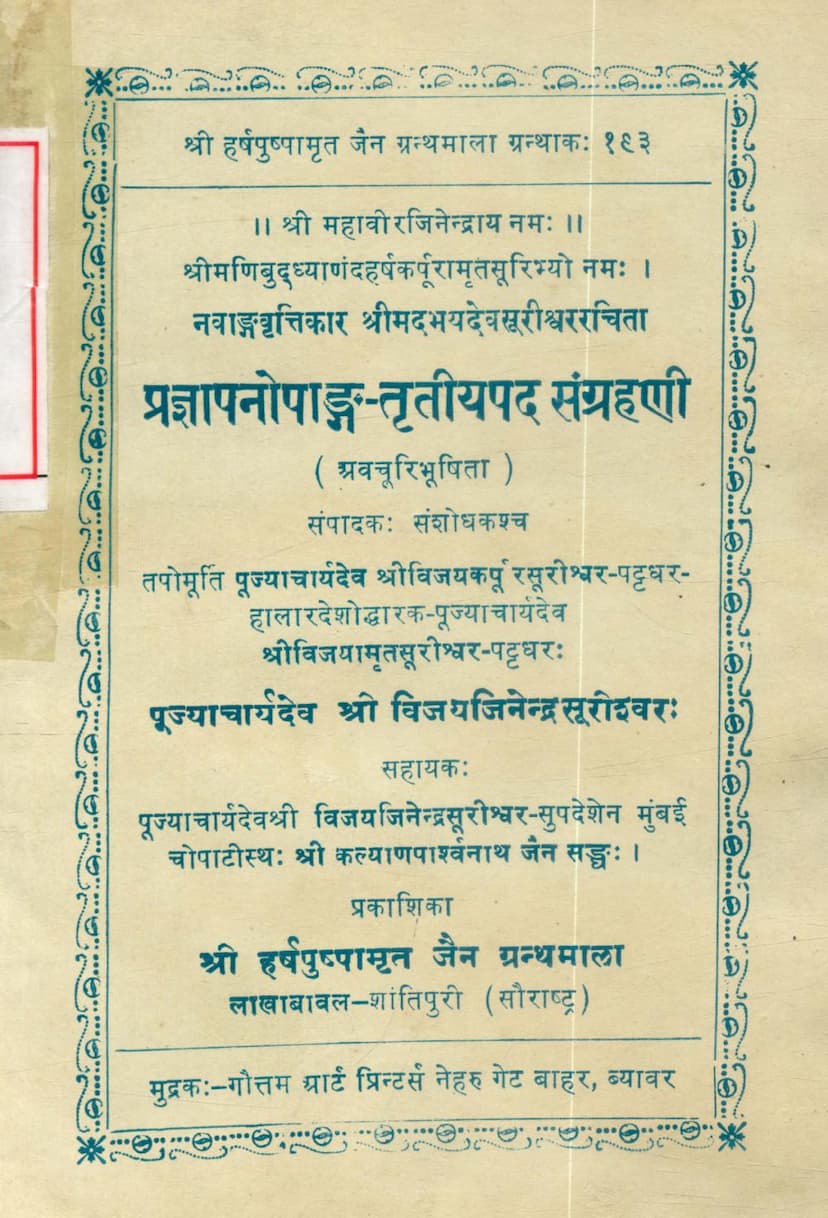Pragnapanopang Tritiya Pad Sangrahani
Added to library: September 2, 2025

Summary
Here's a comprehensive summary of the Jain text "Pragnapanopang Tritiya Pad Sangrahani" by Vijayjinendrasuri, based on the provided pages:
Book Title: Pragnapanopang Tritiya Pad Sangrahani Author: Vijayjinendrasuri (based on the work of Abhaydeva Suri) Publisher: Harshpushpamrut Jain Granthmala Catalog Link: https://jainqq.org/explore/022608/1
Overall Purpose and Context:
This text, "Pragnapanopang Tritiya Pad Sangrahani," is a collection of summaries and analyses related to the third chapter (Tritiya Pad) of the Pragnapana Sutra, a foundational Jain scripture. The work is attributed to the commentary of Abhaydeva Suri, with the current edition compiled and edited by Pujyacharya Dev Shri Vijay Jinendra Surishwarji. The primary purpose of this text is to systematically detail the alpabahutva (the relative quantitative comparison of living beings and substances) according to Jain philosophy, categorizing them based on various parameters like direction, type of being, senses, faculties, stages of development, etc.
Key Themes and Structure:
The Sangrahani (collection or compilation) is structured around a series of "Dwaras" (Doors or sections), each focusing on a specific category for the analysis of alpabahutva. The text systematically moves through these categories, providing detailed comparisons.
Summary of Key Dwaras and Their Content:
The provided pages cover a substantial portion of the text, detailing the alpabahutva of various Jain ontological categories. Here's a breakdown of the main areas covered:
- Directions (Disi): The initial sections (Dwaras 1-3) discuss the quantitative distribution of beings (Jivas) across different directions of the universe (east, west, north, south, and their combinations). This involves intricate calculations based on the nature of the Lokas (Jain universe), the presence of islands, oceans, and the unique characteristics of each region. The text explains how the number of beings varies due to factors like available space, climatic conditions, and the nature of the life forms present.
- Types of Beings (Gati, Indriya, Kaya, Veda, Kashaya, Leshya, Samyakttva, Nana, Darshan, Samyama, Upayoga, Ahara, etc.): The bulk of the text systematically enumerates and compares beings based on these categories. This includes:
- Gati (Destiny): Comparing humans, hell-dwellers (Nairayika), gods (Deva), and animals (Tiryak).
- Indriya (Senses): Comparing beings with one, two, three, four, and five senses.
- Kaya (Body/Lifespan): Differentiating between beings with different types of bodies (earth-bodied, water-bodied, fire-bodied, air-bodied, plant-bodied, and the non-embodied, Akaya). This also includes discussions on trasa (mobile) and sthāvara (immobile) beings.
- Veda (Gender/Disposition): Comparing male, female, and sexless beings.
- Kashaya (Passions): Analyzing the relative numbers of beings with and without passions, and those with specific types of passions like pride (mana), anger (krodha), deceit (maya), and greed (lobha).
- Leshya (Aura/Disposition): Comparing beings based on their Lishya, which are the subtle colors or emanations associated with their karmic state (black, blue, grey, yellow, red, white).
- Knowledge (Nana), Perception (Darshan), Restraint (Samyama), Consciousness (Upayoga), Nourishment (Ahara), etc.: The text also delves into comparing beings based on their cognitive abilities, their practices of self-restraint, their modes of consciousness, and their need for sustenance.
- Fulfillment (Paryapta) and Non-Fulfillment (A-paryapta): A significant portion of the text is dedicated to comparing beings based on whether they have completed their necessary stages of development (paryapta) or are still in the process (a-paryapta).
- Subtle vs. Gross (Sukshma vs. Badara): The text consistently differentiates between subtle and gross forms of beings and substances, comparing their numbers accordingly. This is particularly relevant for the nigodas (minute beings).
- Monadic Analysis (Dravya and Pradesha): The text makes a distinction between dravya (substance or essence) and pradesha (spatial units or points). It analyzes the relative quantities of various substances (souls, matter, time, space, dharma, adharma) based on their essential nature (dravya-artha) and their spatial extent (pradesha-artha).
- Time (Adha) and States of Being (Bhava): The concept of time (adha-samaya) and various states of being (like consciousness, action, etc.) are also analyzed in terms of their relative abundance.
- Maha-Dandaka (Great Series): The later sections introduce the "Maha-Dandaka," a more complex hierarchical comparison, often involving the juxtaposition of various categories of beings from different realms (heavens, hells, human realm, animal realm) and their stages of development. This part often uses illustrative examples and comparative figures to highlight the vast quantitative differences.
- Types of Souls (Jiva): The text also compares different categories of souls based on their origination (birth-type: womb-born, egg-born, moist-born, and self-generated) and their specific modes of existence.
Key Jain Philosophical Concepts Illustrated:
- Alpabahutva: The entire text is a treatise on alpabahutva, a core concept in Jainism that quantifies the relative numbers of different types of souls and substances. This highlights the Jain understanding of the vastness and diversity of existence.
- Loka: The intricate descriptions of beings in different parts of the Jain universe (Urdhva Loka, Tiryak Loka, Adho Loka) illustrate the Jain cosmology.
- Karmic Dispositions: The analysis of Kashaya and Leshya demonstrates how internal states and passions influence the quantitative distribution of beings.
- Soul-Matter Interaction: The discussions on the relative quantities of souls and matter, and their various modifications, underscore the Jain doctrine of the interaction between consciousness and matter.
- Transmigration (Samsara): The underlying theme of comparing beings across different states of existence implicitly refers to the cycle of birth, death, and rebirth.
Editorial and Publication Information:
The text is presented as part of the Shri Harshpushpamrut Jain Granthmala, volume 193. It acknowledges the editorial work of Pujyacharya Dev Shri Vijay Karpur Surishwar and the patronage of Pujyacharya Dev Shri Vijayamrut Surishwar. The publication is a result of the guidance of Pujyacharya Dev Shri Vijay Jinendra Surishwar and the support of the Shri Kalyan Parshwanath Jain Sangh in Mumbai. A corrigendum (Shuddhipatraka) is included, indicating corrections made to the published text.
In essence, the "Pragnapanopang Tritiya Pad Sangrahani" serves as a detailed, systematic, and quantitative exposition of Jain cosmology and ontology, providing a framework for understanding the relative magnitudes of various entities within the Jain philosophical system.